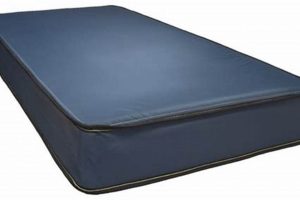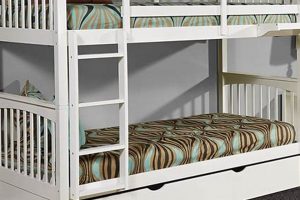A bed designed for a single occupant that conforms to the shape and movement of a powered, articulating frame constitutes a specific sleep solution. These mattresses are built with dimensions typically around 38 inches wide and 75 inches long, enabling compatibility with smaller adjustable platforms.
The integration of this sleep surface type with an adjustable base promotes individualized comfort and support. Users can modify the bed’s position to alleviate pressure points, reduce back pain, and enhance circulation. Historically, adjustable beds were primarily found in healthcare settings, but their appeal has broadened as consumers recognize the advantages for lifestyle enhancement.
Consideration must be given to mattress materials, construction, and flexibility when selecting the optimal model. The following sections will delve into the critical factors that determine suitability and long-term performance for this specific mattress and base pairing.
Optimizing the Selection of a Mattress for an Adjustable Platform
The following guidance offers insights into selecting a properly sized mattress for use with an adjustable foundation, ensuring both comfort and functionality.
Tip 1: Assess Mattress Flexibility: Evaluate the mattress’s capacity to bend and conform to the adjustable base’s various positions. Mattresses that are too rigid may not properly articulate, potentially causing discomfort or damage.
Tip 2: Consider Material Composition: Memory foam and latex mattresses typically demonstrate superior flexibility and responsiveness to movement compared to innerspring models. Consider these materials for enhanced adaptability.
Tip 3: Review Mattress Height Specifications: Ensure that the mattress height is compatible with the adjustable base’s design. Excessively thick mattresses may impede articulation, while overly thin options may compromise support and comfort.
Tip 4: Evaluate Edge Support: Assess the level of edge support provided by the mattress. Adequate edge support is crucial for stability and ease of getting in and out of bed, especially when the base is in an elevated position.
Tip 5: Verify Warranty Compatibility: Confirm that using the mattress with an adjustable base does not void the manufacturer’s warranty. Some warranties may have specific restrictions regarding use with adjustable frames.
Tip 6: Research Motion Isolation Properties: Evaluate the motion isolation properties of the mattress, particularly if sharing the bed. Superior motion isolation minimizes the transfer of movement, promoting undisturbed sleep.
Tip 7: Check Base’s Weight Capacity: Verify the adjustable base’s weight capacity and ensure it is sufficient to support both the mattress and the individual(s) sleeping on it. Exceeding the weight limit can compromise the base’s functionality and longevity.
Selecting a mattress that effectively complements an adjustable platform requires careful attention to material properties, design characteristics, and compatibility considerations. Prioritizing these factors ensures a comfortable and supportive sleep experience.
The concluding section will discuss the long-term maintenance and care required to maximize the lifespan of both the mattress and the adjustable bed frame.
1. Flexibility
Flexibility is a paramount characteristic of any mattress intended for use on an adjustable bed frame. The capacity of the mattress to conform precisely to the contours created by the articulating base is essential for both user comfort and the integrity of the mattress itself.
- Conformability and Pressure Relief
A flexible mattress adapts to the raised head or foot sections of the adjustable base, ensuring that pressure points are minimized regardless of the bed’s configuration. Without adequate flexibility, the mattress may create concentrated pressure, leading to discomfort or disrupted sleep. For example, a mattress that remains rigid when the head is elevated could cause increased pressure on the lower back.
- Durability and Longevity
Insufficient flexibility can cause internal stress on the mattress materials, potentially leading to premature wear and tear. Repeated bending of a rigid mattress can result in broken coils (in the case of innerspring models) or cracking and deformation in foam-based mattresses. The result is a shortened lifespan and diminished support.
- Material Properties and Construction
The inherent flexibility of a mattress is directly related to the materials used in its construction and the way those materials are assembled. Latex and memory foam are typically more flexible than traditional innerspring systems, allowing them to bend and contour more readily. Mattress construction techniques, such as zoned support systems, also play a role in enhancing overall flexibility.
- Compatibility with Adjustable Base Functionality
A flexible mattress ensures full utilization of the adjustable base’s features. The ability of the mattress to seamlessly transition between various positions, from flat to inclined, maximizes the potential therapeutic benefits, such as improved circulation and reduced back pain. A mattress that resists articulation limits the user’s ability to find the optimal sleeping position.
In conclusion, flexibility is not merely a desirable attribute but a fundamental requirement for mattresses designed for adjustable bed frames. It is a critical determinant of comfort, durability, and the realization of the intended functionality of the adjustable base system.
2. Material Composition
The selection of materials significantly influences the performance and longevity of a mattress used on an adjustable bed frame. The inherent properties of these materials dictate the mattress’s flexibility, support, and overall comfort. Therefore, a careful evaluation of material composition is crucial.
- Memory Foam Density and Responsiveness
Memory foam’s density impacts its ability to conform to the body’s contours and provide pressure relief. Higher-density memory foam offers enhanced support and durability, while lower-density options may exhibit greater initial softness but reduced long-term performance. The responsiveness, or speed at which the foam recovers its shape, affects ease of movement on the mattress, particularly when the adjustable base is in motion. For example, a slow-responding memory foam may create a feeling of being “stuck” when changing positions.
- Latex Type (Natural vs. Synthetic)
Natural latex, derived from rubber trees, offers excellent elasticity, breathability, and durability. Synthetic latex, typically made from petroleum-based materials, can provide similar properties but
may be less durable and have lower breathability. Dunlop and Talalay are two processing methods affecting latex density and firmness. Dunlop latex tends to be denser and firmer, while Talalay latex is generally softer and more consistent. These variations impact the mattress’s overall feel and suitability for different sleeping preferences. - Innerspring Coil Design and Gauge
While less common on adjustable beds due to their reduced flexibility, innerspring mattresses may be used. The coil design (e.g., Bonnell, pocketed) and gauge (thickness) affect the level of support and motion isolation. Pocketed coils, individually wrapped in fabric, minimize motion transfer and conform better to the adjustable base’s contours compared to interconnected Bonnell coils. A lower gauge number indicates a thicker, firmer coil, influencing the mattress’s overall firmness.
- Cover Fabric and Breathability
The mattress cover material significantly impacts breathability and temperature regulation. Natural fibers like cotton and bamboo promote airflow and wick away moisture, contributing to a cooler sleeping environment. Synthetic fabrics, such as polyester, may be less breathable and can trap heat. The cover’s construction, including quilting patterns and added layers, also influences comfort and airflow. Proper breathability is crucial for preventing overheating, especially in memory foam mattresses known for retaining heat.
In summary, the interplay of these material characteristics defines the overall performance of a mattress on an adjustable foundation. Carefully considering the properties of each componentfoam density, latex type, coil design, and cover fabricis essential for selecting a model that maximizes comfort, support, and durability.
3. Motion Isolation
The extent to which movement on one area of a mattress transfers to other areas is termed motion isolation. This characteristic assumes notable importance in the context of a twin mattress paired with an adjustable bed, particularly when the bed is used by individuals susceptible to sleep disturbances. An effective isolation system minimizes the ripple effect caused by positional changes or adjustments to the bed’s configuration. For example, if one individual adjusts the head incline of their side of the bed, a mattress with poor motion isolation will transmit this movement to the other side, potentially waking the other sleeper.
The design and materials of the mattress are principal determinants of motion isolation efficacy. Mattresses employing individually encased coils, memory foam, or latex typically exhibit superior motion dampening capabilities compared to those constructed with interconnected innerspring systems. This is because individually encased components absorb and localize movement, preventing its propagation across the mattress surface. Consider a scenario involving an individual experiencing restless leg syndrome; a mattress with excellent motion isolation ensures that the frequent movements associated with this condition do not significantly disrupt the sleep of a bed partner.
In conclusion, the selection of a twin mattress for an adjustable bed should prioritize motion isolation properties to cultivate a restful sleep environment, especially in shared sleeping arrangements. Understanding the relationship between mattress construction, material composition, and motion transfer is crucial for making informed purchasing decisions and realizing the full benefits of an adjustable bed system. A failure to address this aspect may negate the intended comfort and convenience benefits of an adjustable bed.
4. Edge Support
Edge support, the reinforcement along the perimeter of a mattress, is a critical factor influencing stability and usability, particularly when considering a twin mattress for adjustable bed frames. Adequate edge support enhances the accessible sleeping surface and facilitates ease of ingress and egress.
- Stability and Usable Surface Area
Reinforced edges prevent excessive compression when sitting or lying near the edge of the mattress. This maintains a consistent sleeping surface, preventing the sensation of rolling off and maximizing the usable area of the twin mattress. Without sufficient edge support, the perimeter may collapse, diminishing comfort and creating an unstable feel. For instance, a user relying on the edge for support while getting out of bed might experience an unexpected dip, increasing the risk of falls.
- Structural Integrity and Longevity
Edge support contributes to the overall structural integrity of the mattress, extending its lifespan. Over time, mattresses without adequate reinforcement can develop sagging edges, leading to uneven support and premature wear. This is especially pertinent in adjustable bed applications, where the mattress undergoes frequent articulation. Strong edges resist deformation caused by the repeated bending and straightening associated with adjustable bed functionality.
- Compatibility with Adjustable Frame Functionality
While flexibility is essential, edge support ensures the mattress maintains its shape and support levels when adjusted to various positions. Without robust edges, the mattress might buckle or deform at the perimeter as the adjustable base is raised or lowered. This can compromise the intended ergonomic benefits and reduce the overall comfort provided by the adjustable bed system. Solid edge support allows the mattress to conform smoothly to the adjustable base, ensuring consistent support across the entire surface.
The interaction between edge support and a twin mattress on an adjustable bed impacts not only comfort but also safety and durability. By selecting a mattress with robust edge reinforcement, users can optimize the benefits of the adjustable frame while ensuring a stable and supportive sleep surface. The integration of these features is paramount for a comprehensive and satisfying adjustable bed experience.
5. Height Compatibility
Height compatibility constitutes a crucial consideration when selecting a mattress for adjustable bed frames. The vertical dimension of the sleep surface relative to the base impacts both aesthetic appeal and functional performance of the combined system.
- Accessibility and Ingress/Egress
Mattress height dictates the overall bed height, influencing ease of entry and exit. An excessively tall mattress, when combined with the base, may present challenges for individuals with mobility limitations. Conversely, an insufficient mattress height may result in an uncomfortably low bed profile, requiring excessive bending to enter or exit. A suitable height ensures a comfortable and ergonomic transition to and from the bed. For instance, a user with knee problems would find a lower bed height more difficult to manage.
- Adjustable Base Mechanics and Range of Motion
The height of the mattress can influence the range of motion achievable by the adjustable base. Overly thick mattresses may interfere with the base’s articulation, limiting its ability to achieve desired positions. Conversely,
very thin mattresses may not provide sufficient cushioning or support, especially when the base is inclined. Compatibility is essential to realizing the intended therapeutic benefits of the adjustable bed, such as improved circulation or reduced back pain. A mattress that is too thick could prevent the base from reaching its maximum incline. - Aesthetic Harmony and Proportionality
The visual balance between the mattress and the adjustable base contributes to the overall aesthetic appeal of the bed. A mattress that is disproportionately tall or short may detract from the bed’s visual harmony. Selecting a height that complements the base creates a cohesive and visually pleasing sleep environment. A very thin mattress on a high-profile adjustable base might look visually unbalanced.
- Safety Rail Considerations
If the adjustable bed frame incorporates safety rails, particularly relevant in healthcare or assisted living settings, mattress height must be carefully considered. An inappropriate mattress height could render the safety rails ineffective, increasing the risk of falls. The top of the mattress should ideally align with, or slightly exceed, the height of the safety rails to provide adequate protection. Selecting the proper mattress height in this context is vital for patient safety.
In summary, height compatibility between a twin mattress and adjustable bed frame is not merely a matter of aesthetics but one that significantly impacts accessibility, functionality, and safety. Careful attention to mattress height ensures the optimized performance of the adjustable bed system and a comfortable and secure sleep experience. Failure to consider this aspect may compromise the intended benefits of the adjustable bed. Furthermore, users should always confirm that the weight of mattress plus user/s does not exceed the adjustable bed frames capacity.
Frequently Asked Questions
The subsequent section addresses common inquiries regarding the selection and utilization of twin mattresses designed for compatibility with adjustable bed frames. Understanding these nuances is crucial for optimizing comfort and ensuring long-term satisfaction.
Question 1: Are all mattresses compatible with adjustable bed frames?
No, not all mattresses are designed to function effectively on adjustable bed frames. Mattresses lacking sufficient flexibility may resist articulation, potentially causing damage to the mattress or the adjustable base. Memory foam and latex mattresses generally exhibit superior compatibility due to their inherent flexibility.
Question 2: What mattress thickness is optimal for an adjustable bed?
The ideal mattress thickness depends on the adjustable base’s design and the user’s preferences. Excessively thick mattresses may impede articulation, while overly thin options may compromise support. A mid-range thickness, typically between 8 and 12 inches, often provides a balance of comfort and functionality.
Question 3: Does the weight of the mattress affect the adjustable bed’s performance?
Yes, the total weight of the mattress and occupant(s) must not exceed the adjustable base’s weight capacity. Exceeding the weight limit can compromise the base’s functionality and potentially cause damage. Consult the manufacturer’s specifications for weight limit information.
Question 4: Are there specific mattress types to avoid for adjustable beds?
Traditional innerspring mattresses with interconnected coils are generally less suitable for adjustable beds due to their limited flexibility. Hybrid mattresses with a thick innerspring layer may also present challenges. Mattresses with rigid borders or reinforced edges can also impede proper articulation.
Question 5: How does mattress density affect the adjustable bed experience?
Mattress density influences support and contouring. Higher-density memory foam, for instance, provides greater support and pressure relief, while lower-density options may be more plush. The ideal density is a matter of personal preference and body weight.
Question 6: Will using a mattress on an adjustable base void its warranty?
Potentially. Some mattress warranties have specific clauses regarding use with adjustable bases. It is imperative to review the warranty terms and conditions to ensure that using the mattress on an adjustable frame does not invalidate the coverage.
In conclusion, selecting the appropriate twin mattress for an adjustable bed requires careful consideration of compatibility factors, weight limitations, and warranty implications. Prioritizing these aspects ensures a comfortable, supportive, and durable sleep solution.
The next section will explore specific maintenance procedures to extend the lifespan of both the mattress and the adjustable bed frame.
Twin Mattress for Adjustable Bed
This exploration has delineated critical considerations for selecting a suitable twin mattress intended for use with an adjustable bed frame. Key factors include flexibility, material composition, motion isolation, edge support, and height compatibility. A thorough understanding of these elements ensures optimized performance and long-term satisfaction.
Prioritizing these aspects will yield not only a comfortable and supportive sleep environment, but also extend the longevity of both the mattress and adjustable bed frame. Users are advised to carefully evaluate their individual needs and preferences, consulting manufacturer specifications and warranty information to ensure a comprehensive and informed purchasing decision. The integration of a properly chosen twin mattress for adjustable bed can then deliver the desired therapeutic benefits and contribute to an improved overall quality of life.


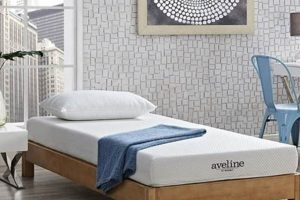
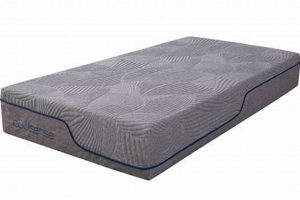
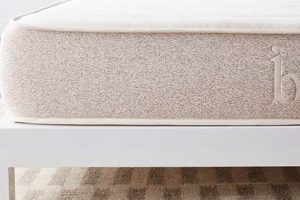
![Best Walmart Twin Size Blow Up Mattress [Guide] Organic & Natural Mattress Buyer’s Guide: Non-Toxic Sleep Solutions Best Walmart Twin Size Blow Up Mattress [Guide] | Organic & Natural Mattress Buyer’s Guide: Non-Toxic Sleep Solutions](https://mattressworldpa.com/wp-content/uploads/2025/07/th-5075-300x200.jpg)
